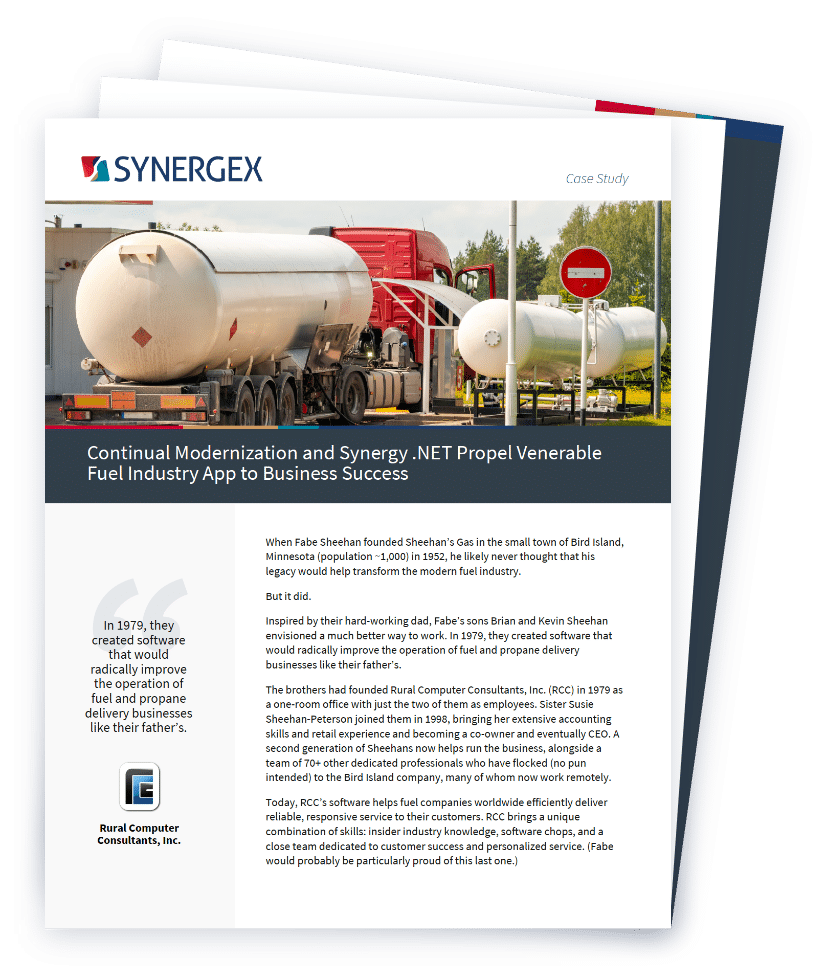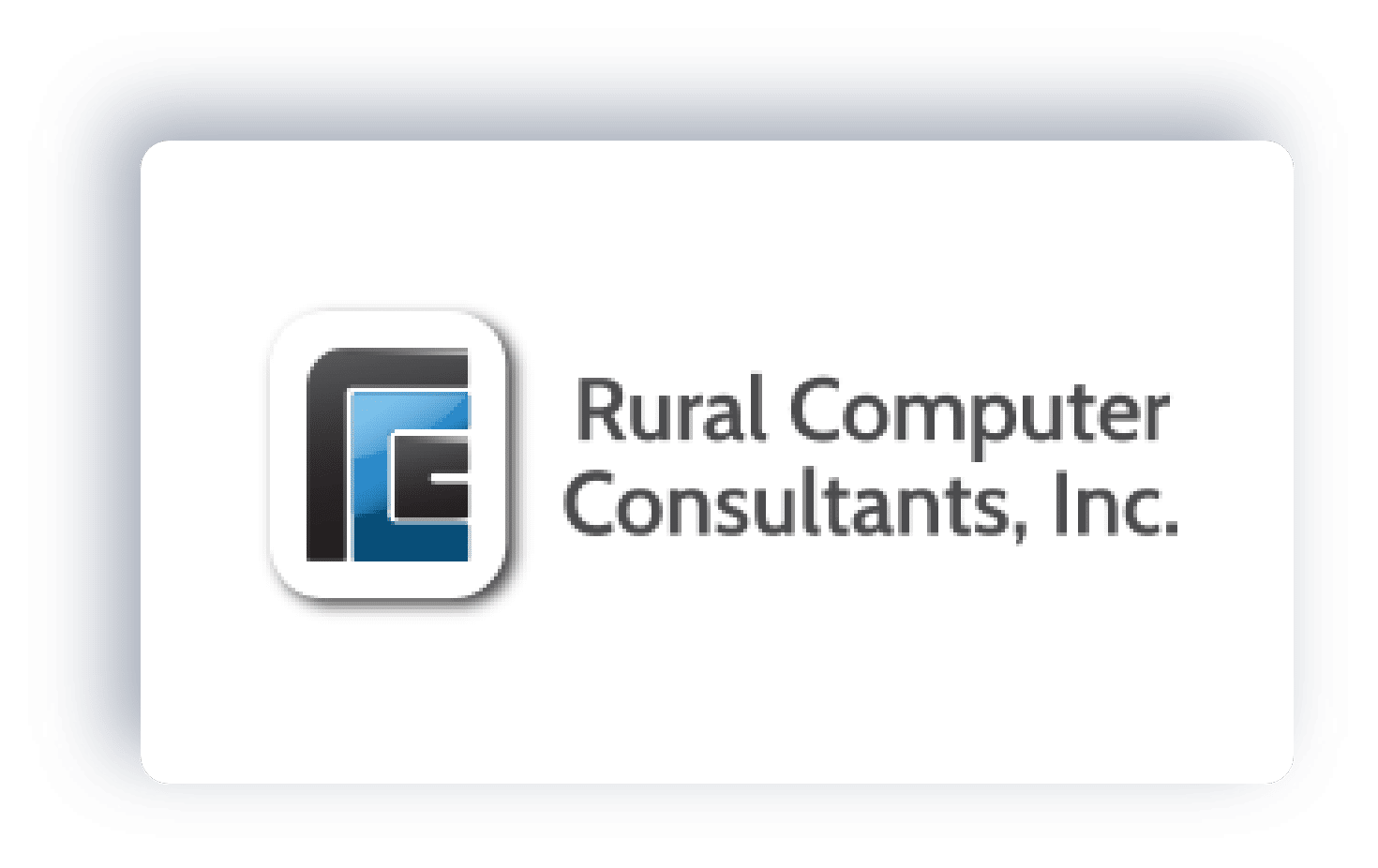
Continual Modernization and Synergy .NET Propel Venerable Fuel Industry App to Business Success
When Fabe Sheehan founded Sheehan’s Gas in the small town of Bird Island, Minnesota (population ~1,000) in 1952, he likely never thought that his legacy would help transform the modern fuel industry.
But it did.
Inspired by their hard-working dad, Fabe’s sons Brian and Kevin Sheehan envisioned a much better way to work. In 1979, they created software that would radically improve the operation of fuel and propane delivery businesses like their father’s.
The brothers had founded Rural Computer Consultants, Inc. (RCC) in 1979 as a one-room office with just the two of them as employees. Sister Susie Sheehan-Peterson joined them in 1998, bringing her extensive accounting skills and retail experience and becoming a co-owner and eventually CEO. A second generation of Sheehans now helps run the business, alongside a team of 70+ other dedicated professionals who have flocked (no pun intended) to the Bird Island company, many of whom now work remotely.
Today, RCC’s software helps fuel companies worldwide efficiently deliver reliable, responsive service to their customers. RCC brings a unique combination of skills: insider industry knowledge, software chops, and a close team dedicated to customer success and personalized service. (Fabe would probably be particularly proud of this last one.)
“In 1979, they created software that would radically improve the operation of fuel and propane delivery businesses like their father’s.”
Rural Computer Consultants, Inc.
The brand promise: “Everything under one roof, for fuel people by fuel people”
RCC provides software, equipment, and services to fuel distributors.
Built to maximize efficiencies and profits for propane and fuel companies, RCC’s flagship Synergy application, the Fuel Distribution System (FDS), manages a typical day in the fuel industry with ease. Now at Version 10, FDS automates all aspects of the business.
With FDS, customers get a one-stop solution for their business operations.
Customers can schedule and route deliveries, quickly produce everything from timely statements to detailed reports, manage inventory and degree days/forecasting, handle payroll, communicate and conduct e-commerce with customers, and more. A cloud option enables clients to outsource the management of their FDS applications on a subscription basis.
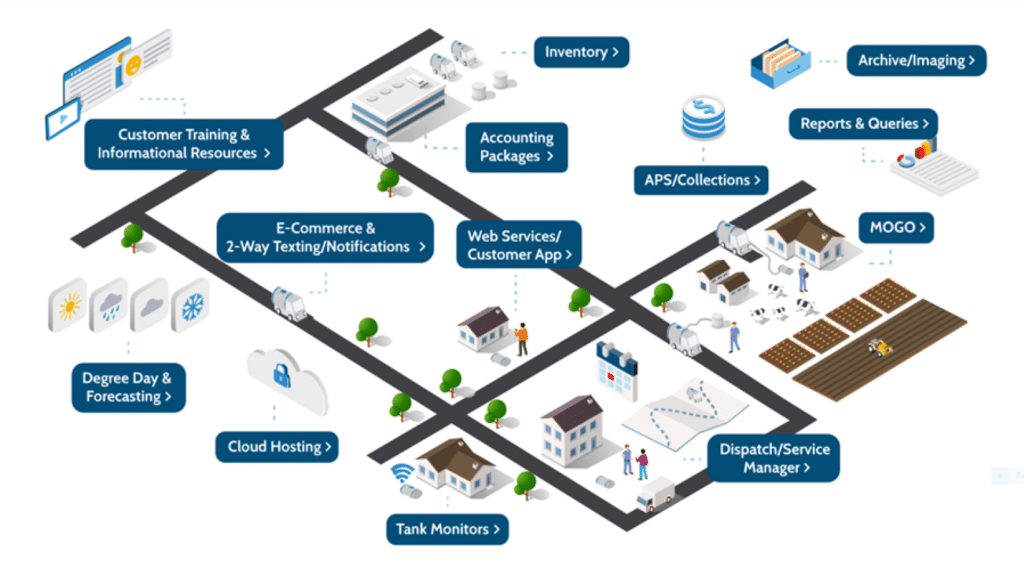
Source: RCC, Inc.
FDS modules include General Ledger, Accounts Payable, Inventory Control, and Payroll as well as ancillary modules for delivery management, tank monitoring, dispatch management, and other tasks. Customers can buy FDS as an integrated system or on a per-module basis. Multiple third-party interfaces let FDS integrate with popular accounting software packages, apps, and various third-party devices. An industry-leading mobile application (Mobile Office on the Go) automates routing and scheduling fuel deliveries for high efficiency.
All of this technology is backed by RCC’s legendary dedication to customer support. This includes its “one call does it all” service promise, founding philosophy of application simplicity, and responsive professional services team.
Today, around a thousand companies worldwide and an estimated 10,000 individuals use the FDS solution daily.
Fueling growth through continual application innovation and investment
Not surprisingly, keeping up with customers’ changing needs and growing competition over the years has made modernization an ongoing priority for RCC. And a challenge.
The company thus has made a habit of investing in a software update every 7 to 10 years—a strategy that’s more than paid off.
The founders had started out by custom-programming a COBOL software application for the LP gas business, later combining it with an existing, off-the-shelf accounting package (also written in COBOL) and so on.
Fast-forward to the late 1990s. The Sheehans realized the look and feel of their application was less than friendly, coupled with a need to address Y2K concerns. Their research suggested that Windows was gaining dominance. They wanted to move their application forward to capitalize on GUIs and to be able to act on future technology opportunities faster.
Another side of their computer business (insurance automation) had an application written in Synergy DBL. Impressed by both the Synergy/DE technology and the committed people behind it, RCC ultimately decided to convert their application to Synergex’s Synergy DBL.
“With the move to Synergy .NET, we’ve been able to bring on new developers much quicker. If you know C#, you can pick up on Synergy .NET very quickly. With Visual Studio as their IDE, they’re closing out tasks and fixing bugs by the end of their first days. It’s been a big win for everybody.”
Nate Bahl, Head of Development | Rural Computer Consultants, Inc.
Going web and mobile
The new application provided a GUI using Synergex’s UI Toolkit. RCC continued to expand its application and grow their business, but they eventually started having trouble with competitors who were coming in with shinier UIs.
In 2009, needing to refresh their look, they started using .NET and creating a new UI with WPF. They initially embedded the .NET code in their Synergy application. However, this process was challenging, as their UI code was mixed in with their business logic. This greatly limited the developers.
In 2010 Synergex released Synergy .NET, which enabled developers to build Synergy DBL code to run under Microsoft’s .NET Framework—and to develop that code in Microsoft Visual Studio. Synergy DBL Integration for Visual Studio provided IntelliSense code-editing features, auto-formatting, and other powerful developer features. This was pivotal for RCC. Focusing on the most used functions first, they gradually and incrementally separated their business logic back end from their UI and rewrote their application—the back end with Synergy .NET and the front-end client application with WPF (C# and XAML).
They also created new client apps for FDS: a web hub written in Angular that provides browser access to many FDS features and a WPF mobile app (MOGO) that automates all aspects of fuel deliveries. It runs on 12-inch tablets that slide into docks in the fuel delivery trucks. MOGO prints client invoices, live-captures driver tasks as they are completed, and optimizes the routes for efficiency.
“The MOGO application has made the drivers’ jobs so much easier,” says Head of Development Nate Bahl. “From the built-in mapping that takes them turn by turn to their destinations, to the ability to measure to the tenth of a gallon how much is pumped at a site, and then generate and print an invoice in the truck to leave with the customer… it has significantly enhanced the experience for both the drivers and their customers.”
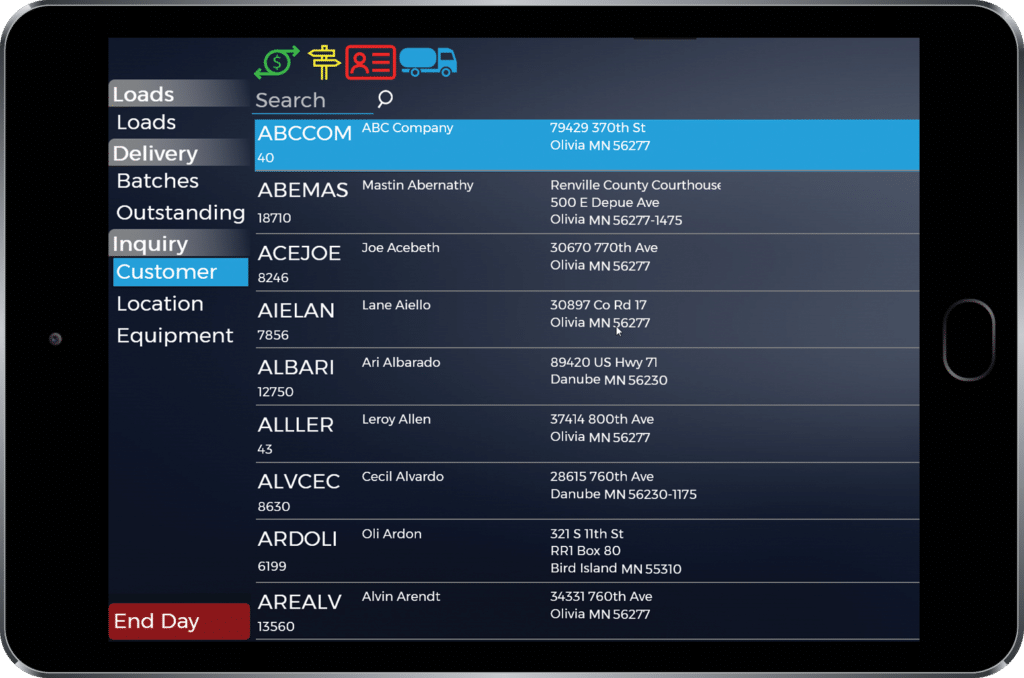
The stack: Accommodating business growing pains and gains
RCC’s growth has been rapid and steady, even with growing competition. The company went mostly remote post-COVID, a boon for the development organization in attracting new talent and fresh ideas.
RCC’s code base has swelled over the years as it has expanded its solutions for customers, growing from a basic application converted from COBOL to the full-fledged, modular enterprise application platform available today. Compounding the modernization challenge: no customer runs their business the same, so the software requires diverse configurations and many switches.
Today, RCC’s software stack includes:
- Their back-office FDS Synergy application, which houses all their business logic
- A REST API from which all clients access FDS
- A WPF (desktop) back-office application
- A WPF mobile app (MOGO)
- A customer app written in MAUI
- A customer web hub written in Angular
About 90% of the FDS functionality is .NET (~75% Synergy and ~15% C#); the other ~10% is traditional Synergy, which RCC continues to move over. The REST API is built with ASP .NET Web API 2. (It could be created with Synergex’s Harmony Core open-source platform today, but that was not available when RCC needed this solution.)
Nate Bahl and his team of 18 programmers keep development moving. With Microsoft Visual Studio now RCC’s IDE, it’s much easier to onboard and keep new developers. Developers with respective skills work on the WPF and Angular front ends. The back-office application is mostly Synergy .NET, but today getting up to speed on that is easy for new developers.
“The developer experience is critical for us in order to stay competitive,” says Nate. “With the move to Synergy .NET, we’ve been able to bring on new developers much quicker. If you know C#, you can pick up on Synergy .NET very quickly. With Visual Studio as their IDE, they’re closing out tasks and fixing bugs by the end of their first days. It’s been a big win for everybody.”
“As a technology leader in our industry, our success is deeply rooted in our partnership with Synergex. Their dedication to technology innovation has enabled us to continuously maintain our competitive edge. We’re excited to see where our technological journey takes us, and we’re confident our collaboration with Synergex will continue to be a key driver of our ongoing success.”
Jason Buetow, CTO | Rural Computer Consultants, Inc.
A strategic move: a highly efficient, integrated, and simple user experience
With the help of Synergy .NET, RCC has ridden its pioneering code base and logic to the bank. It prides itself on delivering a superior, modern customer experience and functionality, with highly personalized and responsive support.
As the company and its application grew, it became time to consider another redesign. RCC made a strategic decision back in 2015: It invested in a relationship with Billy Hollis of Next Version Systems, a well-known user-experience (UX) design consultant whom RCC first encountered at the annual Synergex DevPartner Conference. Hollis helped RCC dissect, analyze, and reengineer its customer experience. Among other things, he worked with application users at their workflow levels and created small, internal “scrimmage” teams of developers to generate new ideas and responsive applications. (RCC continues to work with the Hollis team.)
The new design approach was extremely successful in the redesign of the customer application. Version 10 was much more intuitive, provided a lot more functionality directly from the main hub, and was visually engaging and appealing. When RCC started showing the new application to their customers, those who were considering moving to a competitor put the brakes on. “The investment in UX redesign was a good-sized investment but well worth our money and time,” says Brian Sheehan.
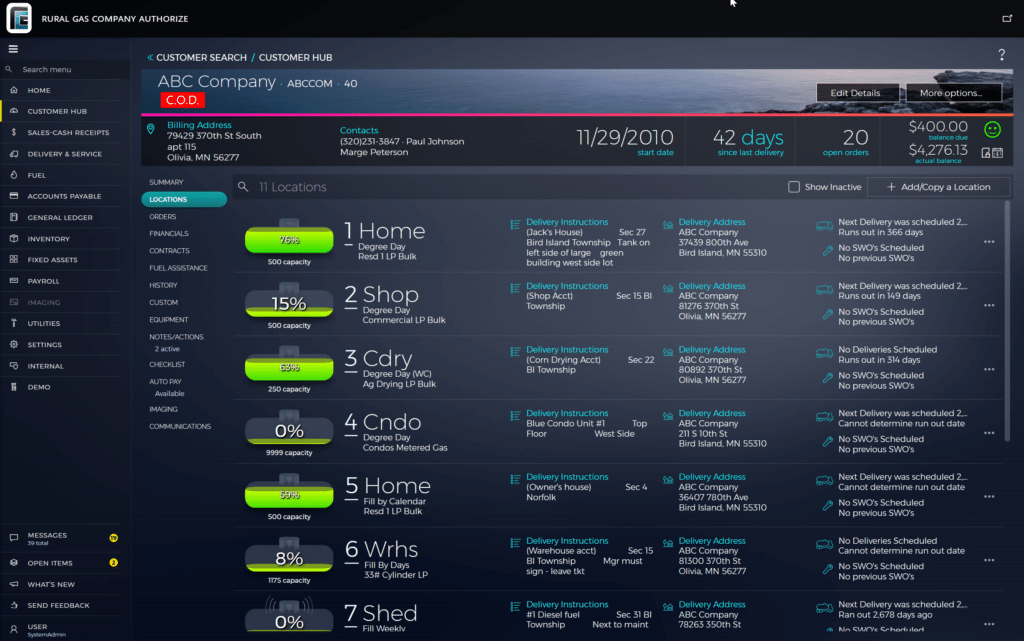
Now trained with the knowledge and skills for creating a great UX, the developers used the same process when developing the MOGO app.
“Moving to Synergy .NET was a game changer for us,” summarizes Nate. “If we hadn’t made that move when we did, the business wouldn’t have grown nearly as fast as it did. We couldn’t have been able to produce code as fast as we can now. We were able to get more developers onboarded and contributing faster. Our competition is two to three times bigger than us, but we’re able to keep up.”
He concludes: “The modernization of the application has definitely made our customers happier. We work very closely with them. They feel like they can come to us with anything, and we’ll listen. We’re able to produce solutions quickly and responsively.”
What’s next for RCC
The Sheehan legacy of technology innovation and customer service continues. With Brian and Susie retiring in June 2024, following Kevin’s earlier retirement, the next generation of Sheehans are now leading the company to new heights.
“As a technology leader in our industry, our success is deeply rooted in our partnership with Synergex. Their dedication to technology innovation has enabled us to continuously maintain our competitive edge. We’re excited to see where our technological journey takes us, and we’re confident our collaboration with Synergex will continue to be a key driver of our ongoing success,” says Jason Buetow, CTO.
Under the guidance of 22-year programming vet Nate Bahl and his energetic development team, RCC plans to continue expanding and improving their solution to keep their users happy and stay ahead of their competitors.
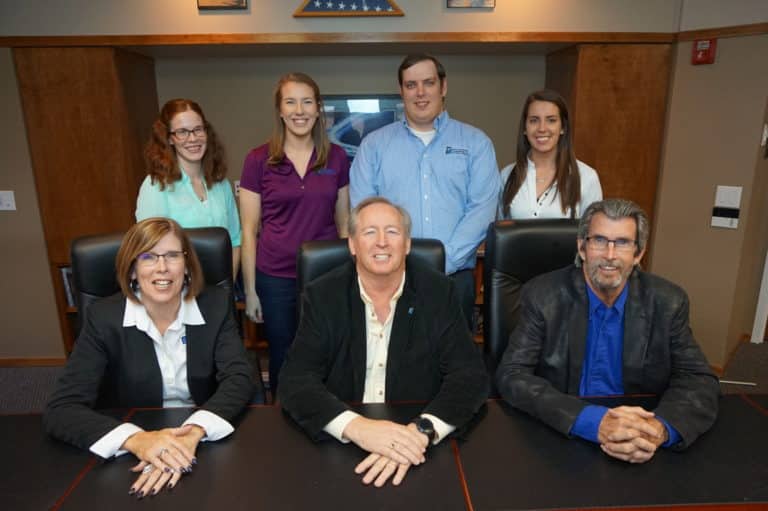
The second generation of leadership continues to uphold the values and culture of Rural Computers.
“Everything we’ve done over the last 10 years with Synergy .NET has set our applications up beautifully for the future, wherever they’re needed—running on watches or beyond,” affirms Nate.
Ready for your Synergy .NET journey?
Today, the combination of .NET and Synergy .NET (now supporting .NET 8 on Windows and Linux and also .NET Framework) can radically simplify and improve any business-critical Synergy application development.
Developers can add new functionality with .NET or migrate existing traditional Synergy programs—from one full of business logic to a simple utility that needs to perform some extra tasks that are just plain easier in .NET. This provides tremendous flexibility in building new apps and modernizing existing apps.
How easy? Imagine this:
Move the parts of your applications that need new functionality over to Synergy .NET. Build that part of your code to run on .NET and run the rest with the traditional Synergy runtime. Then find a .NET library that already has the features you need (the ecosystem is huge) and add it to your app.
Working with .NET enables new-hire developers to be immediately more productive. And your company can iterate quickly on ideas and experiment with new functionality.
Bottom line? You can be innovative, customer-responsive, and efficient without a lot of heavy lifting. While, like RCC, staying true to your roots.

